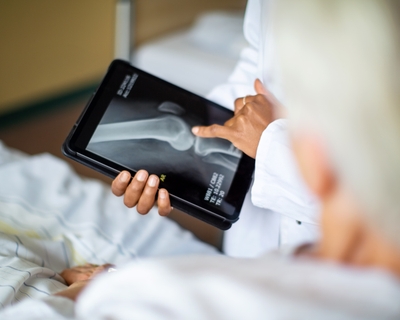It might have been a cardinal — or maybe the wind in the trees — that distracted me for a few seconds this spring. But a few seconds was all it took.
As I gazed upward, another pooch and its human quietly turned the corner behind me. My dog, a German shepherd-border collie mix, spotted a potential friend and took off with a lunge — all 65 pounds of her — pulling free the leash I had looped over my wrist and wrapped several times around my hand “to control her.”
“It wasn’t her fault, though,” I explained to the nurses at my local emergency room when I arrived with one broken finger and another one dislocated.
They answered in unison: “That’s what they all say.”
Really? I had no idea this was A Thing. But I quickly learned that aside from bites, injuries caused by household pets (particularly dogs and cats) are surprisingly common. And once I recovered from my injury and regained full use of both hands, I sat down to report and write the following story.
With pets in an estimated 68% of U.S. households, there’s no doubt we love our four-legged companions. They bring us joy, reduce loneliness, offer unconditional love and even improve our health — lowering our blood pressure and encouraging us to get more exercise. Unless we’re careful, however, the very pets we adore can contribute to serious injuries.

While we’re all aware that dogs and cats may bite or scratch, we tend to overlook the very real dangers of tripping, falling and leash-related injuries that can result in sprains, dislocations, complicated fractures and worse.
“These injuries, especially falls, are actually very common, especially among the older population,” said Kelly Moriarty, injury-prevention coordinator for Novant Health trauma services at Presbyterian Medical Center in Charlotte.
How common are pet-related injuries?
Cats and dogs were associated with more than 86,000 fall injuries a year from 2001 to 2006, according to estimates from the U.S. Centers for Disease Control and Prevention. But this number, the CDC reported, may be vastly understated, since the study did not include injuries treated at home, in doctors’ offices or other outpatient settings.
What is certain, however, is that older people bear the brunt of these injuries. One study revealed that between 2004 and 2017, the number of people 65 and older who went to U.S. emergency rooms for fractures associated with dog walking increased significantly. Older women, in particular, are more vulnerable to fractures from falling or from muscle compression that occurs during walking, with hip fractures being most common.Walking the dog
Whenever we venture outside with the family dog, the possibility of injury exists, especially for those who struggle with balance issues, Moriarty said.
“You’d be amazed at how strong even a small dog can be when they see something they want to investigate. And, being pulled by a strong dog can also cause sprains, strained muscles and back and shoulder pain.”
Your dog’s leash, depending on how you hold it, also can cause serious injuries. Many dog-walkers (understandably) slip their hand and wrist (that’s a bad idea, see box) through that “convenient” loop handle. Others wrap the leash around their palm or wind it in and out of their fingers to help them control their dogs.
But if the dog pulls or lunges, this can cause the leash to come loose, causing dislocations, fractures, sprains and — in some cases — severed fingers, Moriarty said.
“If you have one of those retractable leashes and your dog pulls or lunges quickly, the action of that thin cable against your skin can cause friction burns to your arms or legs,” she said. “If it’s actually wrapped around your hand, it can dig into the skin and cause more serious hand injuries.”
9 ways to avoid pet-related injuries
- Choose your leash wisely. Look for a leash with a comfortable grip, and make sure it’s not too long. For large breeds and pups who pull, well-fitting harnesses can be safer.
- Encourage good canine manners. Look for local classes or obedience schools to help you train your dog not to jump up on people, and to walk politely at your side.
- Walk one dog at a time. “Walking three dogs at once, each pulling you in a different direction, can cause injury,” she said. Instead, stagger their walks or invite some dog-walking helpers to join you.
- Hold the leash rather than wrapping it around your wrist or hand. And don’t exercise your dog by holding the leash while you ride a bike.
- Place pets in another room when necessary. This is especially helpful when tackling tasks that distract you or make it hard to see what’s under your feet.
- Stay focused. Pay attention to what’s happening around you — especially traffic, sidewalk conditions and other animals that may catch your dog’s eye.
- Choose your breed carefully. If you have balance issues or small children who will want to walk the dog, consider adopting (or buying) a smaller breed.
- Work on your balance. Balance exercises, including yoga, that Moriarty teaches in her fall-prevention classes help people stay steady on their feet.
- Exercise your dog daily. “Dogs who get out every day are a little less likely to go get overly excited and misbehave because they have less energy to burn off.”
Injured? Get walk-in orthopedic care.











